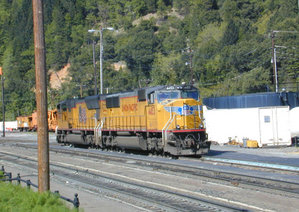|
Từ điển Oxford Advanced Learner 8th
 locomotive
locomotive

loco·mo·tive [locomotive locomotives] BrE [ˌləʊkəˈməʊtɪv] NAmE [ˌloʊkəˈmoʊtɪv] (also informal loco)noun, adjective
noun
a railway engine that pulls a train
•steam/diesel/electric locomotives
Word Origin:
early 17th cent. (as an adjective): from modern Latin locomotivus, from Latin loco (ablative of locus ‘place’) + late Latin motivus ‘motive’, suggested by medieval Latin in loco moveri ‘move by change of position’.
Culture:
railways and railroads
The world’s first railway along which passengers travelled on trains pulled by steam locomotives was opened in 1825 between Stockton and Darlington in north-east England. By the early 1900s, when railways reached the height of their popularity, there were about 23 000 miles/37 000 kilometres of railway track. ↑Victorian engineers such as Isambard Kingdom Brunel designed bridges for the railway, and architects designed elaborate station buildings such as ↑St Pancras in London.
The railways played a vital role in Britain’s industrial development during the 19th and early 20th centuries. Later, with the invention of the internal combustion engine (= the type of engine used in cars), ↑road transport became more popular for both goods and passengers. In 1947 regional railway companies were nationalized and became ↑British Rail (later BR), but following the Beeching report in 1963 many lines (= routes) were closed in order to save money. In 1994 the government decided that BR should be returned to private ownership. Tracks and stations were made the responsibility of a company called ↑Railtrack, while trains were once again operated by several companies on a regional basis. People have been encouraged to use trains and other forms of public transport to help reduce fuel consumption and pollution.
The railway network connects all the major towns in Britain, and now, via the ↑Channel Tunnel, links Britain with France and Belgium. Railways are used for both short and long journeys, for commuting to work each day, and for transporting freight. In 2003 more than a billion journeys were made by rail in Britain and rail travel had increased by 36% in ten years. Some routes are now electrified and have high-speed trains. Others still rely on diesel-powered locomotives. Some trains are old, dirty and overcrowded. They also have a reputation for being late, and jokes are often made about the excuses given for delays. These have included ‘leaves on the line’ in autumn, and ‘the wrong kind of snow’. Tickets are quite expensive, although students and old people can get railcards which entitle them to cheaper fares.
Following several major railway accidents and the failure of the Railtrack company in 2002 the government set up ↑Network Rail to be responsible for the railway system used by the train operating companies, private companies which run the trains. These companies provide information about trains to the public through their organization, National Rail.
Most Americans have never been on a train. This is sad because the railroads, as they are generally called in the US, were the means by which the ↑Old West was settled. Passenger trains today mainly serve commuters around large cities. The only major long-distance railway business is done by freight trains (BrE also goods trains).
The first US rail company was the Baltimore & Ohio Railroad in 1828, but its cars (BrE carriages) were pulled by horses. Steam power was used by the 1830s, and the ↑Pullman car was invented in 1856. The Civil War led to the rapid development of railroads, and the nation was connected from east to west in 1869 when the ↑Union Pacific Railroad and Central Pacific joined their tracks in ↑Utah. The 20th century brought more powerful locomotives and huge stations, like Grand Central in New York. The greatest period of US railroads began in the middle of the 19th century and lasted about 100 years. This time has been celebrated with popular songs like I’ve Been Working on the Railroad, Freight Train Blues, ↑John Henry, ↑Chattanooga Choo Choo, Orange Blossom Special and ↑Casey Jones. Trains and railroad workers were also the subjects of many films and novels.
After ↑World War II car ownership greatly increased and people no longer used trains as a means of transport. Union Pacific, once known for its two-level ‘dome lounge cars’ from which passengers could see the scenery, stopped long-distance passenger services in 1971. Amtrak, a company controlled by the government, now runs the California Zephyr, the Texas Eagle and other trains but it is not very successful in attracting passengers.
Some Americans are train buffs and take special steam locomotive trips. Americans also collect model trains, some of which, including the heavy Lionel sets from the 1940s, are now valuable. In Britain old and young alike visit railway museums at e.g. Didcot and ↑York. Trainspotting (= recording the names and registration numbers of locomotives) used to be a popular hobby, especially for boys, but is less common now.
adjective (formal)
connected with movement
Word Origin:
early 17th cent. (as an adjective): from modern Latin locomotivus, from Latin loco (ablative of locus ‘place’) + late Latin motivus ‘motive’, suggested by medieval Latin in loco moveri ‘move by change of position’.
See also: ↑loco
|
|
|
▼ Từ liên quan / Related words
Related search result for "locomotive"
|
|
